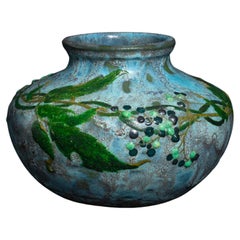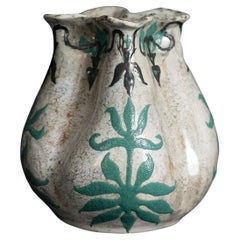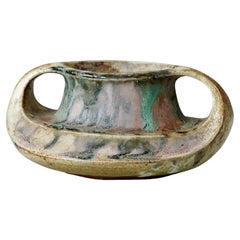Charles Robalbhen Furniture
to
2
2
2
2
2
2
2
2
2
2
2
2
2
2
7,546
3,967
2,548
2,244
Creator: Charles Robalbhen
Art Nouveau Berries & Vines Vase by Henri-Leon Charles Robalbhen
By Charles Robalbhen
Located in Chicago, US
This piece is a unique, one of a kind piece, not a mass-produced factory piece.
Category
Early 1900s French Art Nouveau Antique Charles Robalbhen Furniture
Materials
Stoneware
Art Nouveau Stylized Tulip Vase by Henri-Leon Charles Robalbhen
By Charles Robalbhen
Located in Chicago, US
This piece is a unique, one of a kind piece, not a mass-produced factory piece.
Category
Early 1900s French Art Nouveau Antique Charles Robalbhen Furniture
Materials
Stoneware
Related Items
Art Nouveau Pottery Vase by Charles Greber. Beauvais, France, circa 1920.
By Pierre-Adrien Dalpayrat, Auguste Delaherche, Clement Massier, Charles Greber
Located in Malmö, SE
A beautiful art nouveau vase with amazing glaze.
Made by Charles Gréber in his studio in Beauvais, France in early 20th Century.
Great condition. Signed by the artist.
Reputed ce...
Category
Early 20th Century French Art Nouveau Charles Robalbhen Furniture
Materials
Ceramic
H 2.68 in W 5.83 in D 4.93 in
Ceramic Vase with Tulip Decor attributed to Moorcroft Art Nouveau Style
By Moorcroft Pottery, William Moorcroft
Located in Bad Säckingen, DE
This stunning Art Nouveau ceramic vase, attributed to Moorcroft, features an exquisite hand-painted tulip decor. The deep, glossy glaze accentuates the vibrant yellows and purples of...
Category
20th Century English Art Nouveau Charles Robalbhen Furniture
Materials
Ceramic
Early 20th Century Art Nouveau Glass "Hearts and Vines Vase" by Louis Tiffany
By Louis Comfort Tiffany
Located in London, GB
An impressive early 20th Century American iridescent glass vase of slender form with green hearts shining through an attractive golden iridescence, signed L C Tiffany Favrile and numbered to base.
ADDITIONAL INFORMATION
Height: 23 cm
Condition: Very Good Condition
Circa: 1905
Materials: Iridescent Coloured Glass
SKU: 6667
ABOUT
Louis Comfort Tiffany
Louis Comfort Tiffany (February 18, 1848 – January 17, 1933) was an American artist and designer who worked in the decorative arts and is best known for his work in stained glass. He is the American artist most associated with the Art Nouveau and Aesthetic movements. Tiffany was affiliated with a prestigious collaborative of designers known as the Associated Artists, which included Lockwood de Forest, Candace Wheeler, and Samuel Colman. Tiffany designed stained glass windows and lamps, glass mosaics, blown glass, ceramics, jewellery, enamels and metalwork.
Early Life
He was born in New York City, New York, the son of Charles Lewis Tiffany, founder of Tiffany and Company; and Harriet Olivia Avery Young. He attended school at Pennsylvania Military Academy in West Chester, Pennsylvania, and Eagleswood Military Academy in Perth Amboy, New Jersey. His first artistic training was as a painter, studying under George Inness in Eagleswood, New Jersey and Samuel Colman in Irvington, New York. He also studied at the National Academy of Design in New York City in 1866-67 and with salon painter Leon-Adolphe-Auguste Belly in 1868-69. Belly’s landscape paintings had a great influence on Tiffany.
Career
Louis started out as a painter, but became interested in glassmaking from about 1875 and worked at several glasshouses in Brooklyn between then and 1878. In 1879, he joined with Candace Wheeler, Samuel Colman and Lockwood de Forest to form Louis Comfort Tiffany and Associated American Artists. The business was short-lived, lasting only four years. The group made designs for wallpaper, furniture, and textiles. He later opened his own glass factory in Corona, New York, determined to provide designs that improved the quality of contemporary glass. Tiffany’s leadership and talent, as well as his father’s money and connections, led this business to thrive.
In 1881 Tiffany did the interior design of the Mark Twain House in Hartford, Connecticut, which still remains, but the new firm’s most notable work came in 1882 when President Chester Alan Arthur refused to move into the White House until it had been redecorated. He commissioned Tiffany, who had begun to make a name for himself in New York society for the firm’s interior design work, to redo the state rooms, which Arthur found charmless. He worked on the East Room, the Blue Room, the Red Room, the State Dining Room and the Entrance Hall, refurnishing, repainting in decorative patterns, installing newly designed mantelpieces, changing to wallpaper with dense patterns and, of course, adding Tiffany glass to gaslight fixtures, windows and adding an opalescent floor-to-ceiling glass screen in the Entrance Hall. The Tiffany screen and other Victorian additions were all removed in the Roosevelt renovations of 1902, which restored the White House interiors to Federal style in keeping with its architecture.
A desire to concentrate on art in glass led to the breakup of the firm in 1885 when Tiffany chose to establish his own glassmaking firm that same year. The first Tiffany Glass Company was incorporated December 1, 1885 and in 1902 became known as the Tiffany Studios.
In the beginning of his career, he used cheap jelly jars and bottles because they had the mineral impurities that finer glass lacked. When he was unable to convince fine glassmakers to leave the impurities in, he began making his own glass. Tiffany used opalescent glass in a variety of colors and textures to create a unique style of stained glass. He developed the “copper foil” technique, which, by edging each piece of cut glass in copper foil and soldering the whole together to create his windows and lamps, made possible a level of detail previously unknown. This can be contrasted with the method of painting in enamels or glass paint on colorless glass, and then setting the glass pieces in lead channels, that had been the dominant method of creating stained glass for hundreds of years in Europe. (The First Presbyterian Church building of 1905 in Pittsburgh, Pennsylvania is unique in that it uses Tiffany windows that partially make use of painted glass.) Use of the colored glass itself to create stained glass pictures was motivated by the ideals of the Arts and Crafts movement and its leader William Morris in England. Fellow artists and glassmakers Oliver Kimberly and Frank Duffner, founders of the Duffner and Kimberly Company and John La Farge were Tiffany’s chief competitors in this new American style of stained glass. Tiffany, Duffner and Kimberly, along with La Farge, had learned their craft at the same glasshouses in Brooklyn in the late 1870s.
In 1889 at the Paris Exposition, he is said to have been “Overwhelmed” by the glass work of Émile Gallé, French Art Nouveau artisan. He also met artist Alphonse Mucha.
In 1893, Tiffany built a new factory called the Stourbridge Glass Company, later called Tiffany Glass Furnaces, which was located in Corona, Queens, New York, hiring the Englishman Arthur J. Nash to oversee it. In 1893, his company also introduced the term Favrilein conjunction with his first production of blown glass at his new glass factory. Some early examples of his lamps were exhibited in the 1893 World’s Fair in Chicago. At the Exposition Universelle (1900) in Paris, he won a gold medal with his stained glass windows The Four Seasons
He trademarked Favrile (from the old French word for handmade) on November 13, 1894. He later used this word to apply to all of his glass, enamel and pottery. His first commercially produced lamps date from around 1895. Much of his company’s production was in making stained glass windows and Tiffany lamps, but his company designed a complete range of interior decorations. At its peak, his factory employed more than 300 artisans. Recent scholarship led by Rutgers professor Martin Eidelberg suggests that a team of talented single women designers – sometimes referred to as the “Tiffany Girls” – led by Clara Driscoll played a big role in designing many of the floral patterns on the famous Tiffany...
Category
Early 20th Century American Art Nouveau Charles Robalbhen Furniture
Materials
Glass
H 9.06 in W 0 in D 0 in
French Art Nouveau Vases
Located in Long Island City, NY
An exquisite pair of French Art Nouveau vases in its original patina. It can be turned into a stunning pair of table lamps with marble bases w...
Category
Early 20th Century French Art Nouveau Charles Robalbhen Furniture
Materials
Zinc
Rare Soliflore French Art Nouveau Cameo Glass Vase, Berries Decor by Emile Galle
By Émile Gallé
Located in Bochum, NRW
Delicate soliflore vase with berries and leaves decor.
Multi-layered glass, with a decor intricately cleared with acid through vivid crimson red against a deep yellow glass ground.
T...
Category
1910s French Art Nouveau Vintage Charles Robalbhen Furniture
Materials
Glass
H 4.73 in Dm 2.76 in
Marigold Dugan Carnival Glass Tulip Vase - Opalescent - Orange - Art Nouveau
Located in Beuzevillette, FR
A beautiful tulip vase in opalescent pinkish-orange marigold carnival glass.
The glass is almost iridescent.
The color has marigold iridescence. It is wonderful.
This vase is very de...
Category
Early 20th Century American Art Nouveau Charles Robalbhen Furniture
Materials
Glass
Art Nouveau Rock Crystal Vase by Webb
By Thomas Webb & Sons
Located in Litchfield, CT
Circa 1890, Webb, England. This outstanding rock crystal vase is a sophisticated illustration of Webb’s nineteenth century work. From its curvaceous baluster shape to its gorgeous Ar...
Category
1890s English Art Nouveau Antique Charles Robalbhen Furniture
Materials
Crystal
Art Nouveau Pewter Vase by Kayserzinn
By Hugo Leven, Kayserzinn 1
Located in Los Angeles, CA
Condition: Original Vintage Condition
Materials: Pewter Metal
This exquisite Art Nouveau pewter vase by Kayserzinn, designed by Hugo Leven in the early 1900s, embodies the fluid, ...
Category
Early 1900s German Art Nouveau Antique Charles Robalbhen Furniture
Materials
Pewter
Art Nouveau Vase, signed by Loetz, 1910
By Loetz Glass
Located in Zurich, CH
The vase by Loetz from around 1910, features white glass with a red overlay and is intricately etched with a rose motif. The leafs of the rose stand out in light pinkish to deep purp...
Category
1910s Austrian Art Nouveau Vintage Charles Robalbhen Furniture
Materials
Glass
Charles Catteau for Rambervillers, Art Nouveau Vase w/ Crayfish, France, c. 1904
By Charles Catteau
Located in New York, NY
Before taking over the artistic direction of the Kéramis manufactory in Belgium in 1907, Catteau worked for Sèvres from 1903 and, starting in 1904, for the German manufactory of Nymp...
Category
Early 1900s French Art Nouveau Antique Charles Robalbhen Furniture
Materials
Sandstone
Beautiful Art Nouveau Vase by Ludwig Moser
By Moser Glassworks
Located in Vienna, AT
Original intricate cut glass vase by Moser Glassworks from ca. 1910-1920. Designed by renowned Karlovy Vary based designer Ludwig Moser it features a scal...
Category
1910s Austrian Art Nouveau Vintage Charles Robalbhen Furniture
Materials
Glass, Cut Glass
Loetz Bohemian Glass Art Nouveau Tulip Vases Pair Iridescent Green/Red c. 1880s
By Loetz Glass
Located in Glenford, NY
Rare early pair of Loetz Bohemian Glass Vases in a graceful Tulip Motif made by Johann Loetz Witwe in the 1880s. Green and rich red color with silver and blue iridescent highlights s...
Category
1880s Austrian Art Nouveau Antique Charles Robalbhen Furniture
Materials
Glass
H 13.38 in W 3.75 in D 3.75 in
Charles Robalbhen furniture for sale on 1stDibs.
Charles Robalbhen furniture are available for sale on 1stDibs. These distinctive items are frequently made of stoneware and are designed with extraordinary care. Many of the original furniture by Charles Robalbhen were created in the Art Nouveau style in france during the early 20th century. If you’re looking for additional options, many customers also consider furniture by Ernest Baptiste Leveille, Legras Montjoye, and D'argental. Prices for Charles Robalbhen furniture can differ depending upon size, time period and other attributes — on 1stDibs, these items begin at $2,200 and can go as high as $7,800, while a piece like these, on average, fetch $5,700.



